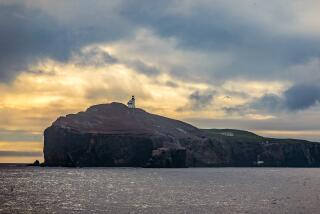Wildlife Drama of Elephant Seal Unfolds at Ano Nuevo
- Share via
One of the best New Year’s resolutions a hiker could make is to plan a winter trip to Ano Nuevo State Reserve. Here you’ll be treated to a wildlife drama that attracts visitors from all over the world--a close-up look at the largest mainland population of elephant seals.
From December through April, a colony of the huge creatures visits Ano Nuevo Island and Point in order to breed and bear young. To protect the elephant seals (and the humans who hike out to see them), the reserve is open only through naturalist-guided tours during these months.
Slaughtered for their oil-rich blubber, the elephant seal population numbered less than 100 by the turn of the century. Placed under government protection, the huge mammals rebounded rapidly from the brink of extinction. Ano Nuevo State Reserve, created to protect the seals, will celebrate its 30th anniversary in 1988.
Male elephant seals, some reaching lengths of 16 feet and weighing three tons, arrive in December and begin battling for dominance. Only a very small percentage of males actually get to inseminate a female; most remain lifelong bachelors. The females, relatively svelte at 1,200 to 2,000 pounds, come ashore in January and join the harems of the dominant males.
La Punta De Ano Nuevo (the Point of the New Year) was named by the Spanish explorer Sebastian Vizcaino on Jan. 3, 1603. It’s one of the oldest place names in California.
At the time of its discovery, the Point was occupied by Ohlone Indians, who lived off the bounty of the sea. Judging from kitchen midden sites (shell mounds) found in the nearby dunes, it was a rich bounty indeed.
The Ano Nuevo area later hosted a variety of enterprises. From the 1850s to 1920, redwood cut from the slopes of the nearby Santa Cruz Mountains was shipped from Ano Nuevo Bay. A dairy industry flourished on the coastal bluffs. The reserve’s visitors center is a restored century-old dairy barn.
While the elephant seals are clearly the main attraction when they come ashore during the winter to breed and during the summer to molt, the reserve is fascinating even when the seals are not in residence. Bird watchers may glimpse a cliff swallow, Western gull, red-tailed hawk and many other inland and shore birds. Joining the elephant seals on Ano Nuevo Island are Steller sea lions, California sea lions and harbor seals. The beautiful sand dunes of the reserve are covered with beach grass, morning glories and extensive patches of beach strawberry.
Directions to trailhead: Ano Nuevo State Reserve is just west of California 1, 20 miles north of Santa Cruz and 30 miles south of Half Moon Bay.
Ano Nuevo Point, where the elephant seals reside, is open only to visitors on guided walks, which are conducted by park volunteers and by volunteer docents of the Ano Nuevo Interpretive Assn. The 2 1/2-hour, 3-mile guided walks are conducted daily.
Advance reservations for the guided walks are strongly recommended. Reservations can be made at Ticketron outlets. You can also use a credit card to make a reservation by phoning Ticketron: (213) 410-1062. Tickets are $4 each. If you reserve your tickets by phone, a $1 handling surcharge per ticket is added. Allow 10 working days to receive your tickets by mail.
Ano Nuevo State Reserve information: (415) 879-0227.
Guided tours along the three-mile trail are available for disabled persons. Information: (415) 879-0454, Tuesday through Friday.
In addition, another, shorter trail designed by state park ranger Nina Gordon, will accommodate wheelchairs. Gordon’s trail utilizes heavy rubber matting to provide the firm surface needed for wheelchairs to cross the reserve’s shifting sand dunes. Information: (415) 879-0454.
Ano Nuevo Trail
Three miles round trip
More to Read
Sign up for The Wild
We’ll help you find the best places to hike, bike and run, as well as the perfect silent spots for meditation and yoga.
You may occasionally receive promotional content from the Los Angeles Times.






